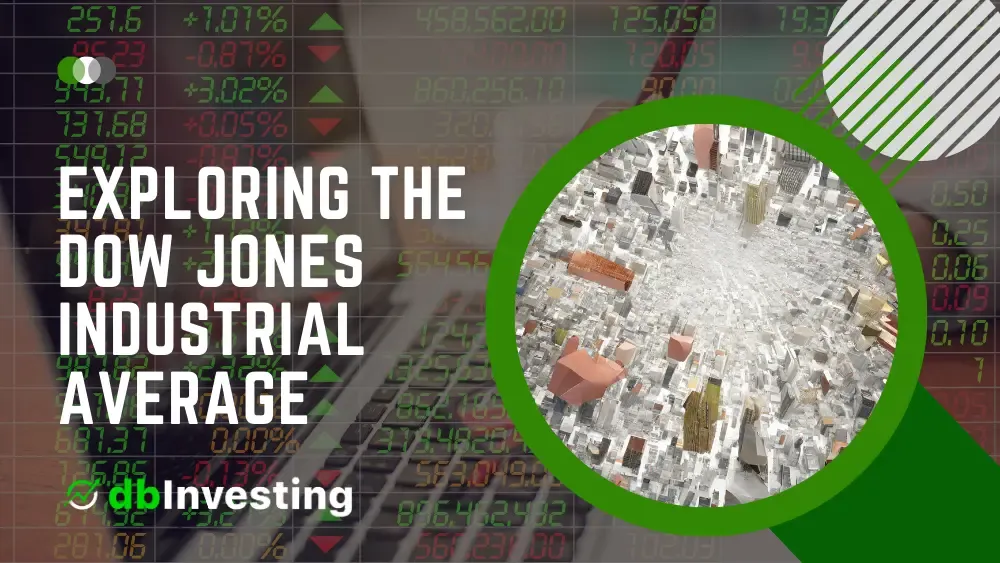ডাউ জোন্স ইন্ডাস্ট্রিয়াল এভারেজের ইতিহাসডিজেআইএ কনস্টিটিউয়েন্ট স্টকগুলি বোঝাডাউ জোন্স ইন্ডাস্ট্রিয়াল এভারেজের তাৎপর্যডাউ জোন্স চার্টডাউ জোন্স চার্টডাউ জোন্স এবং অর্থনৈতিক ঘটনাগুলি কীভাবে ব্যাখ্যা করবেন
ডাও জোন্স ইন্ডাস্ট্রিয়াল এভারেজ (ডিজেআইএ), যা প্রায়শই ডাউ জোন্স বা ডাউ নামে পরিচিত, বিশ্বের সবচেয়ে সুপরিচিত এবং ব্যাপকভাবে অনুসরণ করা স্টক মার্কেট সূচকগুলির মধ্যে একটি। চার্লস ডাউ এবং এডওয়ার্ড জোন্স দ্বারা 1896 সালে প্রতিষ্ঠিত, এই সূচকটি মার্কিন যুক্তরাষ্ট্রের শেয়ার বাজারের পারফরম্যান্স ট্র্যাক করতে গুরুত্বপূর্ণ ভূমিকা পালন করেছে।
এই বিস্তৃত নিবন্ধে, আমরা ডাউ জোন্স ইন্ডাস্ট্রিয়াল এভারেজের ইতিহাস, গঠন, তাৎপর্য এবং এর চার্ট এবং উপাদান স্টক সহ বিভিন্ন দিকগুলি অনুসন্ধান করব।
ডাউ জোন্স ইন্ডাস্ট্রিয়াল এভারেজের ইতিহাস
ডাউ জোন্স ইন্ডাস্ট্রিয়াল এভারেজের একটি সমৃদ্ধ ইতিহাস রয়েছে যা এক শতাব্দীরও বেশি সময় ধরে বিস্তৃত। এটি মার্কিন শেয়ার বাজারের সামগ্রিক পারফরম্যান্স পরিমাপ করার জন্য একটি সরঞ্জাম হিসাবে তৈরি করা হয়েছিল। প্রাথমিকভাবে, সূচকটিতে কেবল 12 টি শিল্প সংস্থা অন্তর্ভুক্ত ছিল এবং এর প্রথম ক্লোজিং ভ্যালু ছিল 26 মে, 1896 এ 40.94। সময়ের সাথে সাথে, সূচকটি আমেরিকান অর্থনীতির পরিবর্তিত গতিশীলতা প্রতিফলিত করার জন্য প্রসারিত এবং বিকশিত হয়েছিল।
ডিজেআইএ বোঝা
ডাউ জোন্স ইন্ডাস্ট্রিয়াল এভারেজকে প্রায়শই "মূল্য-ওজনযুক্ত" সূচক হিসাবে উল্লেখ করা হয়। S&P 500 এর মতো অন্যান্য সূচকগুলির বিপরীতে, যা বাজার মূলধন দ্বারা ওজন করা হয়, DJIA তার উপাদান কোম্পানিগুলির স্টক মূল্যের সংক্ষিপ্তসার এবং একটি ভাজক দ্বারা ভাগ করে তার মূল্য গণনা করে।
এই অনন্য পদ্ধতির শক্তি এবং সীমাবদ্ধতা উভয়ই রয়েছে, কারণ এটি সূচকের মধ্যে স্টকগুলির পরম মূল্য পরিবর্তন দ্বারা প্রভাবিত হতে পারে।
উপাদান স্টক
ডাউ জোন্স ইন্ডাস্ট্রিয়াল এভারেজ মার্কিন অর্থনীতির বিভিন্ন খাতের প্রতিনিধিত্বকারী 30 টি বৃহত্তর, ব্লু-চিপ সংস্থা নিয়ে গঠিত।
এই সংস্থাগুলিকে সূচকের পরিচালন পর্ষদ এসঅ্যান্ডপি ডাও জোন্স সূচক সাবধানতার সঙ্গে বেছে নেয় এবং প্রায়শই এদেরকে শিল্পপতি হিসাবে বিবেচনা করা হয়। কিছু সুপরিচিত ডাউ উপাদানগুলির মধ্যে রয়েছে অ্যাপল, মাইক্রোসফ্ট, কোকা-কোলা এবং গোল্ডম্যান স্যাকস।
#CompanySymbolWeight PriceChg% Chg1UnitedHealth Group IncUNH9.889526 505.22-0.23(-0.05%)2গোল্ডম্যান স্যাকস গ্রুপ IncGS6.373112 326.722.90(0.89%)3Microsoft CorpMSFT6.154111 313.771.63(0.0.0.)52%)4হোম ডিপো IncHD5.939956 303.080.54(0.18%)5ক্যাটারপিলার ইনকসিএটি5.315513 270.450.93(0.35%)6ম্যাকডোনাল্ডস কর্পএমসিডি5.228495 268.530.81(0.30%)7Amgen IncAMGN5.171903 268.58-0.46(-0.17%)8ভিসা ইনকভি4.522654 230.200.55(0.24%)9Salesforce IncCRM3.99899 203.591.10(0.54%)10Boeing CoBA3.852473 196.570.93(0. 48%)11Honeywell International IncHON3.718359 189.952.06(1.10%)12Apple IncAAPL3.412534 172.540.58(0.34%)13Chevron CorpCVX3.269699 168.560.76(0.45%)14Travelers Cos IncTRV3.14 252838 168.670.71(0.42%)15ওয়ালমার্ট ইনকডাব্লুএমটি3.160392 162.800.30(0.18%)16জনসন অ্যান্ড জনসনJNJ3.105933 158.58-0.45(-0.28%)17আমেরিকান এক্সপ্রেস CoAXP2.969687 151.860.74(0.49%)18প্রক্টর অ্যান্ড গ্যাম্বল CoPG2.919879 149.340.02(0.01%)19Intl বিজনেস মেশিনস কর্পআইবিএম2.838868 143.660.42(0.29%)20Jpmorgan Chase &CoJPM2.838287 145. 610.68 (0.47%)21Merck &Ko. Inc.MRK2.051241 105.750.36(0.34%)223m CoMMM1.837086 94.340.46(0.48%)23Nike IncNKE1.755881 90.590.42(0.46%)24ওয়াল্ট ডিজনি CoDIS1.24 570021 80.370.32(0.40%)25Coca Cola CoKO1.104693 56.590.06(0.11%)26Cisco Systems IncCSCO1.036474 52.850.14(0.27%)27Dow IncDOW0.990154 50.700.22(0.44%)28Intel CorpINTC0.66456 33.950.12(0.37%)29Verizon Communications IncVZ0.64266 33.070.08(0.24%)30Walgreens Boots Alliance IncWBA0.413582 21.190.06(0.26%)27.09.23 সর্বশেষ আপডেট
ডাও জোন্স ইন্ডাস্ট্রিয়াল এভারেজের তাৎপর্য
ডাউ জোন্স ইন্ডাস্ট্রিয়াল এভারেজকে ব্যাপকভাবে মার্কিন শেয়ার বাজারের স্বাস্থ্যের ব্যারোমিটার এবং অর্থনৈতিক প্রবণতার মূল সূচক হিসাবে বিবেচনা করা হয়। অনেক বিনিয়োগকারী এবং আর্থিক পেশাদাররা বাজারের অবস্থা মূল্যায়ন, বিনিয়োগের সিদ্ধান্ত নেওয়া এবং সামগ্রিক অর্থনৈতিক অনুভূতি পরিমাপ করার জন্য ডাউকে একটি রেফারেন্স পয়েন্ট হিসাবে ব্যবহার করেন।
ডাউ জোন্স চার্ট
একটি ডাউ জোন্স চার্ট সময়ের সাথে সাথে সূচকের ঐতিহাসিক পারফরম্যান্সের একটি গ্রাফিকাল উপস্থাপনা। এই চার্টগুলি বিনিয়োগকারী, বিশ্লেষক এবং ব্যবসায়ীদের জন্য অমূল্য সরঞ্জাম যারা প্রবণতাগুলি কল্পনা করতে, নিদর্শনগুলি সনাক্ত করতে এবং অবহিত বিনিয়োগের সিদ্ধান্ত নিতে চান।
ডাও জোন্স চার্টগুলি লাইন চার্ট, বার চার্ট এবং ক্যান্ডেলস্টিক চার্ট সহ বিভিন্ন আকারে পাওয়া যায় এবং মিনিট থেকে কয়েক দশক পর্যন্ত বিভিন্ন সময়সীমা কভার করতে পারে।
ডাউ জোন্স চার্ট কীভাবে ব্যাখ্যা করবেন
ডাউ জোন্স চার্টগুলি ব্যাখ্যা করার মধ্যে মূল্যের গতিবিধি বিশ্লেষণ করা, সমর্থন এবং প্রতিরোধের স্তরগুলি সনাক্ত করা এবং ভবিষ্যতের মূল্যের গতিবিধি সম্পর্কে ভবিষ্যদ্বাণী করার জন্য প্রযুক্তিগত সূচক ব্যবহার করা জড়িত। ট্রেডার এবং বিনিয়োগকারীরা প্রায়শই ট্রেডিং সিদ্ধান্ত নেওয়ার জন্য প্রবণতা, চার্ট প্যাটার্ন (যেমন মাথা এবং কাঁধ, ডাবল টপ এবং পতাকা) এবং মূল স্তরগুলি সন্ধান করে।
ডাউ জোন্স এবং অর্থনৈতিক ঘটনা
ডাও জোন্স ইন্ডাস্ট্রিয়াল এভারেজ অর্থনৈতিক ঘটনা এবং সংবাদ প্রকাশের দ্বারা উল্লেখযোগ্যভাবে প্রভাবিত হতে পারে। ফেডারেল রিজার্ভের ঘোষণা, কর্মসংস্থান প্রতিবেদন, কর্পোরেট আয় এবং ভূ-রাজনৈতিক বিকাশের মতো ঘটনাগুলি সূচকে দ্রুত ওঠানামা করতে পারে। এই ঘটনাগুলি ডাউকে কীভাবে প্রভাবিত করে তা বোঝা বিনিয়োগকারীদের জন্য গুরুত্বপূর্ণ।
উপসংহার
ডাও জোন্স ইন্ডাস্ট্রিয়াল এভারেজ মার্কিন স্টক মার্কেটের পারফরম্যান্স ট্র্যাক করার দীর্ঘ ইতিহাস সহ একটি সম্মানিত সূচক। এটি বিশ্বব্যাপী বিনিয়োগকারী এবং আর্থিক পেশাদারদের জন্য একটি গুরুত্বপূর্ণ মানদণ্ড হিসাবে রয়ে গেছে।
এর ইতিহাস, গঠন এবং তাৎপর্য, পাশাপাশি ডাও জোন্স চার্টগুলি কীভাবে ব্যাখ্যা করা যায় তা বোঝা অর্থ এবং বিনিয়োগের জটিল বিশ্বে নেভিগেট করতে চাইছেন এমন যে কোনও ব্যক্তির জন্য অপরিহার্য।

 প্রাতিষ্ঠানিক সাইট
প্রাতিষ্ঠানিক সাইট 